16-10 The Sun’s magnetic field heats the corona, produces flares, and causes massive eruptions
Astronomers now understand that the Sun’s magnetic field does more than just explain the presence of sunspots. It is also responsible for the existence of spicules, as well as a host of other dramatic phenomena in the chromosphere and corona.
Magnetic Reconnection
In a plasma, magnetic field lines and the material of the plasma tend to move together. Their moving together means that as convection pushes material toward the edge of a supergranule, it pushes magnetic field lines as well. The result is that vertical magnetic field lines pile up around a supergranule. Plasma that “sticks” to these magnetic field lines thus ends up lifted upward, forming a spicule (see Figure 16-12 and Figure 16-13).
The tendency of plasma to follow the Sun’s magnetic field can also explain why the temperature of the chromosphere and corona is so high. Spacecraft observations show magnetic field arches extending tens of thousands of kilometers into the corona, with streamers of electrically charged particles moving along each arch (Figure 16-26a). If the magnetic fields of two arches come into proximity, their magnetic fields can rearrange in a process called magnetic reconnection (Figure 16-26b). The tremendous amount of energy stored in the magnetic field is then released into the solar atmosphere. (A single arch contains as much energy as a hydroelectric power plant would generate in a million years.) The amount of energy released in this way is thought to help maintain the temperatures of the chromosphere and corona.
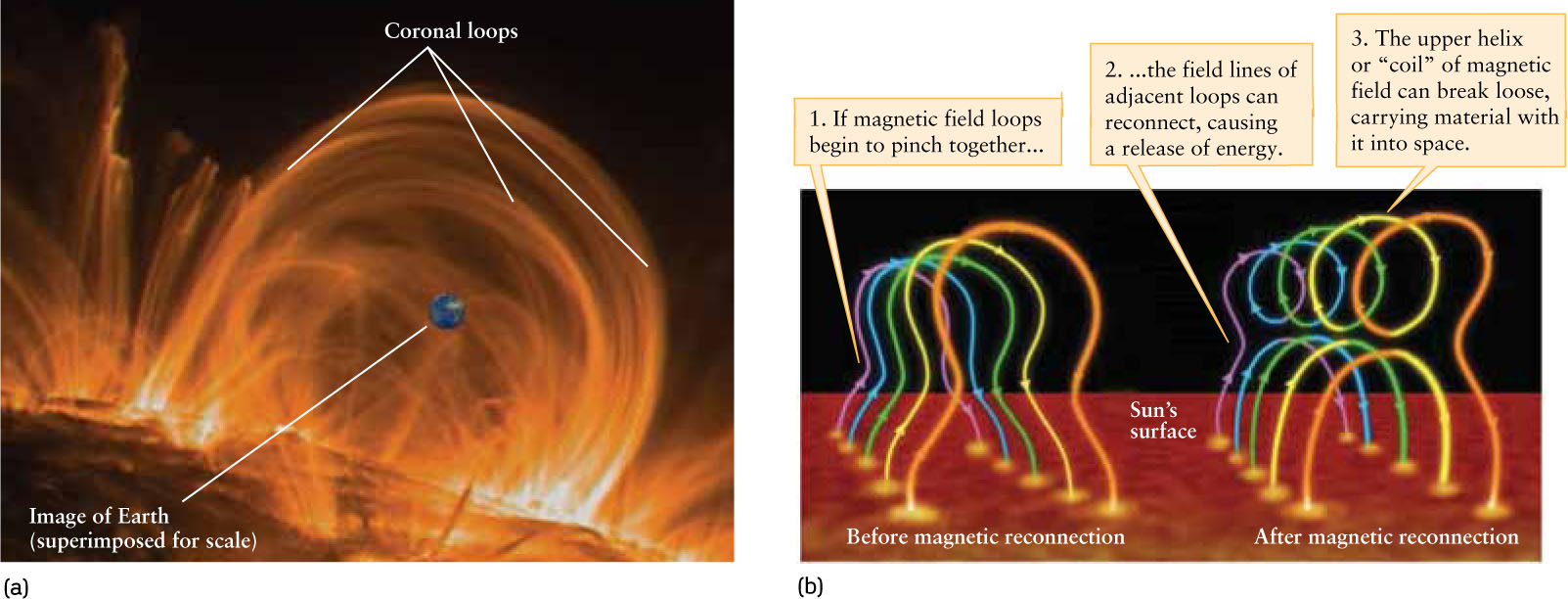
Magnetic Arches and Magnetic Reconnection (a) This false-color ultraviolet image from the TRACE spacecraft (Transition Region and Coronal Explorer) shows magnetic field loops suspended high above the solar surface. The loops are made visible by the glowing gases trapped within them. (b) When the magnetic fields in these loops change their arrangement, a tremendous amount of energy is released and solar material can be ejected upward.
ANALOGY
The idea that a magnetic field can heat gases has applications on Earth as well as on the Sun. In an automobile engine’s ignition system, an electric current is set up in a coil of wire, which produces a magnetic field. When the current is shut off, the magnetic field collapses and its energy is directed to a spark plug in one of the engine’s cylinders. The released energy heats the mixture of air and gasoline around the plug, causing the mixture to ignite. This drives the piston in that cylinder and makes the automobile go.
 Magnetic heating can also explain why the parts of the corona that lie on top of sunspots are often the most prominent in ultraviolet images. (Some examples are the bright regions in Figure 16-16.) The intense magnetic field of the sunspots helps trap and compress hot coronal gas, giving it such a high temperature that it emits copious amounts of high-energy ultraviolet photons and even more energetic X-ray photons.
Magnetic heating can also explain why the parts of the corona that lie on top of sunspots are often the most prominent in ultraviolet images. (Some examples are the bright regions in Figure 16-16.) The intense magnetic field of the sunspots helps trap and compress hot coronal gas, giving it such a high temperature that it emits copious amounts of high-energy ultraviolet photons and even more energetic X-ray photons.
457
CONCEPT CHECK 16-18
Why does glowing plasma on the Sun appear to arch up above the Sun’s photosphere?
Prominences, Flares, and Coronal Mass Ejections
Spicules and coronal heating occur even when the Sun is quiet. But magnetic fields can also explain many aspects of the active Sun in addition to sunspots. Figure 16-27 is an image of the chromosphere made with an Hα filter during a sunspot maximum. The bright areas are called plages (from the French word for “beach”). These plages are bright, hot regions in the chromosphere that tend to form just before the appearance of new sunspots. They are probably created by magnetic fields that push upward from the Sun’s interior, compressing and heating a portion of the chromosphere. The dark streaks, called filaments, are relatively cool and dense parts of the chromosphere that have been pulled along with magnetic field lines as they arch to high altitudes. Images with an Hα filter are made from visible light, and images using ultraviolet light can highlight filaments and sunspots (Figure 16-28).
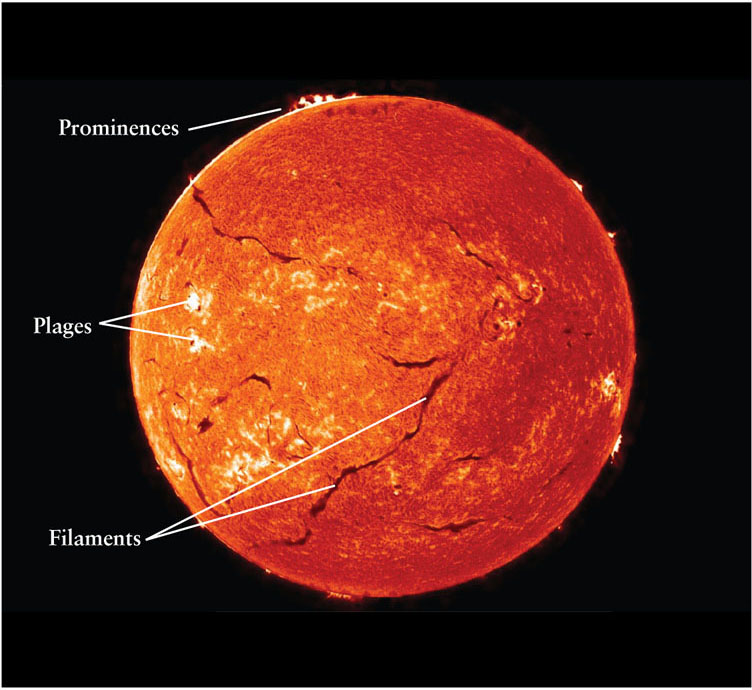
The Active Sun Seen through an Hα Filter This image was made using a red filter that only passes light at a wavelength of 656 nm. The spectrum of the photosphere has an absorption line at this wavelength and so appears dark. Hence, this filter reveals the chromosphere. Prominences, plages, and filaments are associated with strong magnetic fields.
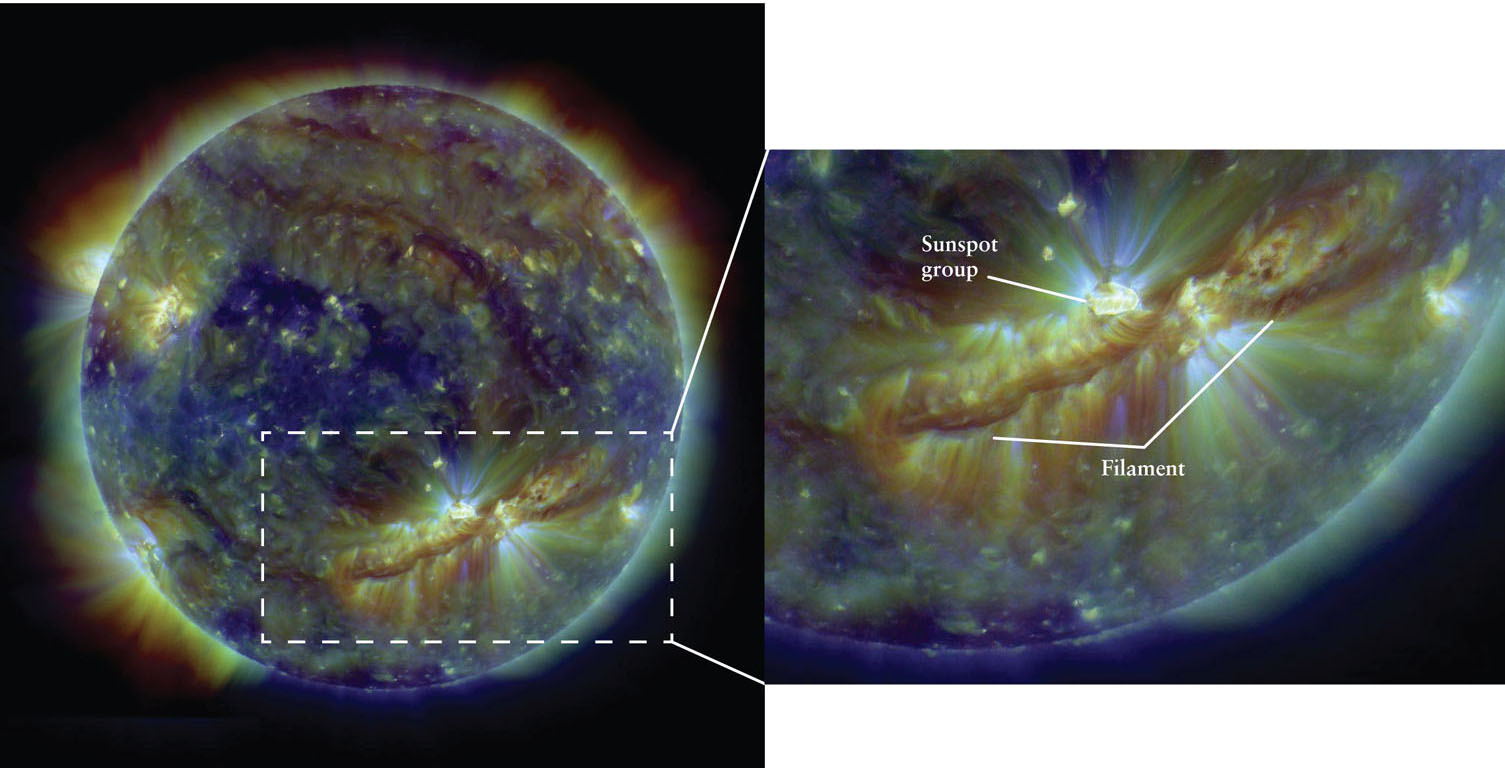
The Sun in Ultraviolet Light This false-color image was made in ultraviolet light by the Solar Dynamics Observatory. A very long filament is seen cutting across the Sun’s southern hemisphere; it is longer than the distance from Earth to the Moon! The filament is confined by a strong magnetic field, and above the filament is a bright sunspot group.
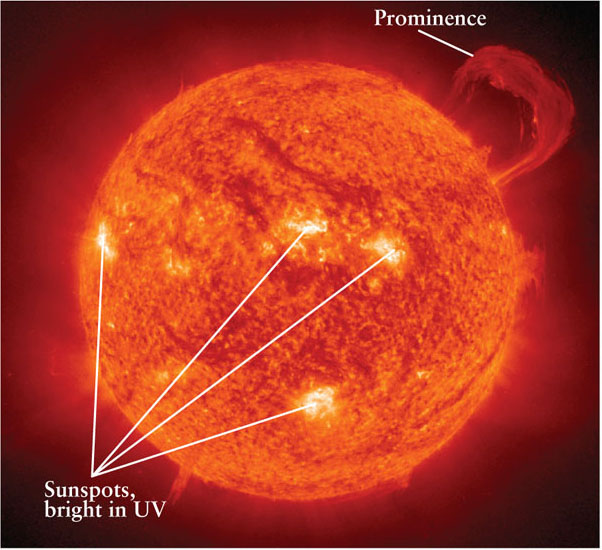
A Solar Prominence A huge prominence arches above the solar surface in this ultraviolet image from the SOHO spacecraft. The image was recorded using ultraviolet light at a wavelength of 30.4 nm, emitted by singly ionized helium atoms at a temperature of about 60,000 K. By comparison, the material within the arches in Figure 16-25 reaches temperatures in excess of 2 × 106 K.
When seen from the side, so that they are viewed against the dark background of space, filaments appear as bright, arching columns of gas called prominences (Figure 16-29). They can extend for tens of thousands of kilometers above the photosphere. Some prominences last for only a few hours, while others persist for many months. The most energetic prominences break free of the magnetic fields that confined them and burst into space.
 Magnetic reconnection also causes violent, eruptive events on the Sun, called solar flares. Rooted to the same magnetic phenomena, the solar flares occur in complex sunspot groups. Within only a few minutes, temperatures in a compact region may soar to 5 × 106 K and vast quantities of particles and radiation—including as much material as is in the prominence shown in Figure 16-29—are blasted out into space. These eruptions can also cause disturbances that spread outward in the solar atmosphere, like the ripples that appear when you drop a rock into a pond.
Magnetic reconnection also causes violent, eruptive events on the Sun, called solar flares. Rooted to the same magnetic phenomena, the solar flares occur in complex sunspot groups. Within only a few minutes, temperatures in a compact region may soar to 5 × 106 K and vast quantities of particles and radiation—including as much material as is in the prominence shown in Figure 16-29—are blasted out into space. These eruptions can also cause disturbances that spread outward in the solar atmosphere, like the ripples that appear when you drop a rock into a pond.
While the external effects of the Sun’s magnetism are on full display with solar flares, the advancing magnetic fields can also be discerned below the surface. Observations from NASA’s Solar Dynamics Observatory employed helioseismology to detect magnetic fields about 65,000 km below the surface (that distance is about 2½ times Earth’s circumference). As predicted, the effects of these magnetic fields emerged several days later as sunspots.
458
A solar flare can have as much energy as 100 trillion nuclear bombs
The most energetic flares carry as much as 1030 joules of energy, equivalent to 1014 one-megaton nuclear weapons being exploded at once! However, the energy of a solar flare does not come from thermonuclear fusion in the solar atmosphere; instead, it appears to be released from the intense magnetic field around a sunspot group.
As energetic as solar flares are, they are dwarfed by coronal mass ejections. One such event is shown in Figure 16-30. If directed toward Earth, these events are large enough to affect us directly (Figure 16-31). In a coronal mass ejection, more than 1012 kilograms of high-temperature coronal gas is blasted into space at speeds of hundreds of kilometers per second. That is about 200 times the mass of the largest Egyptian pyramid, and a typical coronal mass ejection lasts a few hours. These explosive events seem to be related to large-scale alterations in the Sun’s magnetic field, like the magnetic reconnection shown in Figure 16-26b. Coronal mass ejections occur every few months; smaller eruptions may occur almost daily.
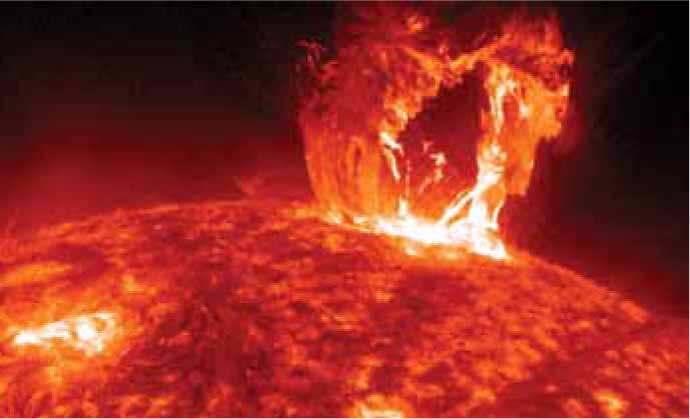
Coronal Mass Ejection The Sun produced a huge coronal mass ejection over several hours on April 16, 2012. Not all of the gas was shot into the solar system, and some material from this event was observed crashing back onto the solar surface. (This ejection was not directed toward Earth.)
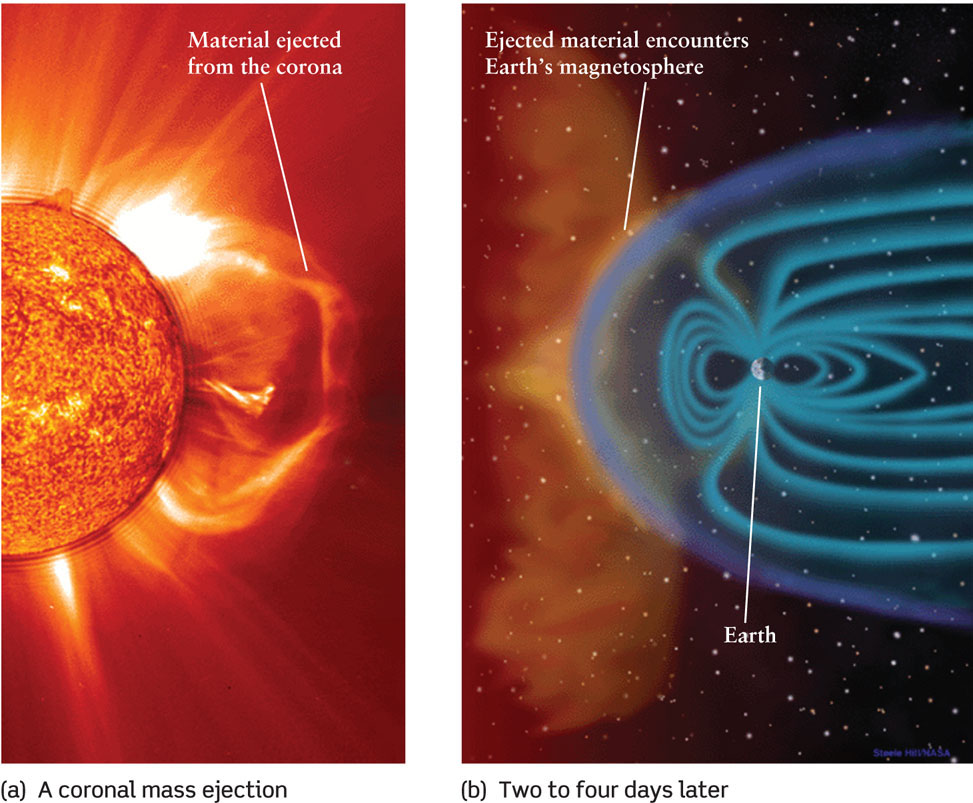
A Sun-Earth Connection (a) SOHO recorded this coronal mass ejection in an X-ray image. (The image of the Sun itself was made at ultraviolet wavelengths.) (b) In this artist’s illustration we see that within two to four days the fastest-moving ejected material reaches a distance of 1 AU from the Sun. Most particles are deflected by Earth’s magnetosphere, but some are able to reach Earth where they can damage satellites and our electrical power grid. (The ejection shown in (a) was not aimed toward Earth and did not affect us.)
If a solar flare or coronal mass ejection happens to be aimed toward Earth, a stream of high-energy electrons and nuclei reaches us a few days later (Figure 16-31b); this is part of space weather (Section 16-9). When this plasma arrives, it can interfere with satellites, pose a health hazard to astronauts in orbit, and disrupt electrical and communications equipment on Earth’s surface. Telescopes on Earth and on board spacecraft now monitor the Sun continuously to provide warnings of dangerous levels of solar particles. By design, the walls of the International Space Station are thick enough to protect astronauts from material ejected during regular solar activity, but extra precautions are needed during a stronger solar event.
459
The numbers of plages, filaments, solar flares, and coronal mass ejections all vary with the same 11-year cycle as sunspots. But unlike sunspots, coronal mass ejections never completely cease, even when the Sun is at its quietest. Astronomers are devoting substantial effort to understanding these and other aspects of our dynamic Sun.
CONCEPT CHECK 16-19
Which of the following phenomena is the most energetic: prominences, solar flares, or coronal mass ejections?